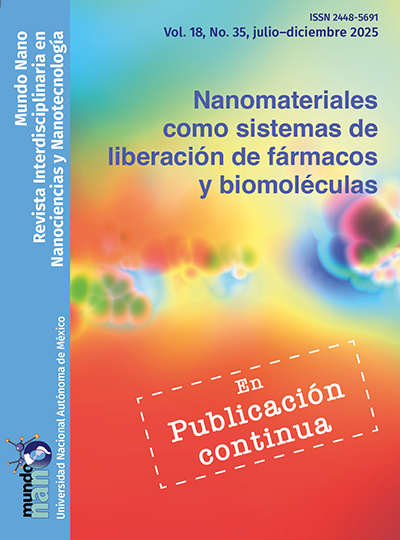Efecto citotóxico de nanopartículas de MgO y ZnO en cultivo con células de cáncer oral: nanoacarreadores para tratamientos quimioterapéuticos
Conteúdo do artigo principal
Resumo
El cáncer oral, una de las principales causas de mortalidad a nivel mundial, se trata comúnmente con quimiorradioterapia. No obstante, estas terapias tienen limitaciones. Investigaciones recientes se enfocan en el uso de nanopartículas (NPs) como MgO y ZnO para mejorar el tratamiento. Y, para evaluar el efecto citotóxico de NPs de MgO y ZnO en células cancerígenas de origen linfoblástico, se utilizaron células cancerígenas de cultivo primario de origen linfoblástico caracterizadas por inmunohistoquímica (HIC) y se realizaron pruebas de citotoxicidad utilizando NPs de MgO y ZnO en concentraciones de 0 a 1.33 mg/mL. La viabilidad celular se midió mediante el ensayo MTT por UV-Vis. El análisis estadístico fue mediante la prueba de t-student y ANOVA (p ≤ 0.05). Los análisis histopatológicos confirmaron la presencia de lesiones neoplásicas linfoblásticas orales con características específicas, positivo a ciclina D1 y negativo a CD3. Los resultados mostraron ligera toxicidad a la máxima dosis para ambas NPs (80% MgO y 94% ZnO) reducción estadísticamente significativa (p < 0.05) dosis-dependiente. Las NPs de MgO y ZnO tienen un ligero efecto citotóxico en células cancerosas linfoblásticas, por lo cual es necesario desarrollar tratamientos quimioterapéuticos más efectivos basados en nanopartículas en combinación con agentes antitumorales para confirmar esta hipótesis.
Downloads
Detalhes do artigo

Mundo Nano. Revista Interdisciplinaria en Nanociencias y Nanotecnología, editada por la Universidad Nacional Autónoma de México, se distribuye bajo una Licencia Creative Commons Atribución-NoComercial 4.0 Internacional.
Basada en una obra en http://www.mundonano.unam.mx.
Referências
Alsahafi, E., Begg, K., Amelio, I., Raulf, N., Lucarelli, P., Sauter, T., Tavassoli, M. (2019). Clinical update on head and neck cancer: molecular biology and ongoing challenges. Cell Death and Disease, 10(8): 540. https://doi.org/10.1038/s41419-019-1769-9.
Behzadi, E., Sarsharzadeh, R., Nouri, M., Attar, F., Akhtari, K., Shahpasand, K., Falahati, M. (2018). Albumin binding and anticancer effect of magnesium oxide nanoparticles. International Journal of Nanomedicine, 14: 257-270. https://doi.org/10.2147/IJN.S186428.
Carneiro, B. A., El-Deiry, W. S. (2020). Targeting apoptosis in cancer therapy. Nature Reviews Clinical Oncology, 17(7): 395-417. https://doi.org/10.1038/s41571-020-0341-y.
Chia, S. L., Tay, C. Y., Setyawati, M. I., Leong, D. T. (2015). Biomimicry 3D gastrointestinal spheroid platform for the assessment of toxicity and inflammatory effects of zinc oxide nanoparticles. Small, 11(6): 702-712. https://doi.org/10.1002/smll.201401915.
DeLong, R. K., Comer, J., Mathew, E. N., Jaberi-Douraki, M. (2019). Comparative molecular immunological activity of physiological metal oxide nanoparticle and its anticancer peptide and RNA complexes. Nanomaterials, 9(12): 1670, Basilea, Suiza. https://doi.org/10.3390/nano9121670.
Deng, H., Yang, Y., Zuo, T., Fang, T., Xu, Y., Yang, J., Zhang, J., Shen, Q. (2021). Multifunctional ZnO@CuS nanoparticles cluster synergize chemotherapy and photothermal therapy for tumor metastasis. Nanomedicine: Nanotechnology, Biology and Medicine, 34: 102399. https://doi.org/10.1016/j.nano.2021.102399.
Franke, C. E., Czapar, A. E., Patel, R. B., Steinmetz, N. F. (2018). Tobacco mosaic virus-delivered cisplatin restores efficacy in platinum-resistant ovarian cancer cells. Molecular Pharmaceutics, 15(8): 2922-2931. https://doi.org/10.1021/acs.molpharmaceut.7b00466.
García-Contreias, R., Scougall-Vilchis, R. J., Contreras-Bulnes, R., Ando, Y., Kanda, Y., Hibino, Y., Nakajima, H., Sakagami, H. (2014). Effects of TiO2 nanoparticles on cytotoxic action of chemotherapeutic drugs against a human oral squamous cell carcinoma cell line. In Vivo, 28(2): 209-215.
Goldar, S., Khaniani, M. S., Derakhshan, S. M., Baradaran, B. (2015). Molecular mechanisms of apoptosis and roles in cancer development and treatment. Asian Pacific Journal of Cancer Prevention, 16(6): 2129-44. https://doi.org/10.7314/apjcp.2015.16.6.2129.
Hao, Q., Chen, J., Lu, H., Zhou, X. (2023). The ARTS of p53-dependent mitochondrial apoptosis. Journal of Molecular Cell Biology, 29: 14(10):mjac074. https://doi.org/10.1093/jmcb/mjac074.
Kashyap, D., Garg, V. K., Goel, N. (2021). Intrinsic and extrinsic pathways of apoptosis: Role in cancer development and prognosis. Advances in Protein Chemistry and Structural Biology, 125: 73-120. https://doi.org/10.1016/bs.apcsb.2021.01.003.
Keefe, D. M., Schubert, M. M., Elting, L. S., Sonis, S. T., Epstein, J. B., Raber-Durlacher, J. E., Migliorati, C. A., McGuire, D. B., Hutchins, R. D., Peterson, D. E. (2007). Updated clinical practice guidelines for the prevention and treatment of mucositis. Cancer, 109(5): 820-831. https://doi.org/10.1002/cncr.22484.
Kiraz, Y., Adan, A., Kartal Yandim, M., Baran, Y. (2016). Major apoptotic mechanisms and genes involved in apoptosis. Tumour Biology, 37(7): 8471-86. https://doi.org/10.1007/s13277-016-5035-9.
Kumar, R., Gokulakrishnan, N., Kumar, R., Krishna, V. M., Saravanan, A., Supriya, S., Somanathan, T. (2015). Can be a bimetal oxide ZnO-MgO nanoparticles anticancer drug carrier and deliver? Doxorubicin adsorption/release study. Journal of nanoscience and nanotechnology, 15(2): 1543-1553. https://doi.org/10.1166/jnn.2015.8915.
Lalla, R. V., Brennan, M. T., Schubert, M. M. (2011). Oral complications of cancer therapy. En Yagiela, J. A., Dowd, F. J., Johnson, B. S. et al. (eds.), Pharmacology and therapeutics for dentistry. 6a ed. Mosby Elsevier, 782-98.
Li, X., Li, R., Qian, X., Ding, Y., Tu, Y., Guo, R., Hu, Y., Jiang, X., Guo, W., Liu, B. (2008). Superior antitumor efficiency of cisplatin-loaded nanoparticles by intratumoral delivery with decreased tumor metabolism rate. European Journal of Pharmaceutics and Biopharmaceutics, 70(3): 726-34. https://doi.org/10.1016/j.ejpb.2008.06.016.
Marei, H. E., Althani, A., Afifi, N. (2021). p53 signaling in cancer progression and therapy. Cancer Cell International, 21: 703. https://doi.org/10.1186/s12935-021-02396-8.
Mendoza-Martínez, N. L., Cadena-Galeana, A. D., Villanueva-Sánchez, F. G., Pérez-Cornejo, N., Avelar-Juárez, K. M., Ramos-Baena, J. D., Cruz-Monroy, E. A., Vázquez-Zúñiga, U., García-Contreras, R. (2023). Efficacy of antineoplastic nanocarriers on 3D oral cancer spheroids. In Vivo, 37(4): 1658-1665. https://doi.org/10.21873/invivo.13251.
Mohammadinejad, R., Moosavi, M. A., Tavakol, S., Vardar, D. Ö., Hosseini, A., Rahmati, M., Dini, L., Hussain, S., Mandegary, A., Klionsky, D. J. (2019). Necrotic, apoptotic and autophagic cell fates triggered by nanoparticles. Autophagy, 15(1): 4-33. https://doi.org/10.1080/15548627.2018.1509171.
Rautureau, G. J., Day, C. L., Hinds, M. G. (2010). Intrinsically disordered proteins in bcl-2 regulated apoptosis. International Journal of Molecular Sciences, 11(4): 1808-24. https://doi.org/10.3390/ijms11041808.
Siegel, R. L., Miller, K. D., Wagle, N. S., Jemal, A. (2023). Cancer statistics, 2023. CA: A Cancer Journal for Clinicians, 73(1): 17-48. https://doi.org/10.3322/caac.21763.
Singh, T. A., Das, J., Sil, P. C. (2020). Zinc oxide nanoparticles: a comprehensive review on its synthesis, anticancer and drug delivery applications as well as health risks. Advances in Colloid and Interface Science, 286: 102317. https://doi.org/10.1016/j.cis.2020.102317.
Song, W., Jia, P., Zhang, T., Dou, K., Liu, L., Ren, Y., Liu, F., Xue, J., Hasanin, M. S., Qi, H. y Zhou, Q. (2022). Cell membrane-camouflaged inorganic nanoparticles for cancer therapy. Journal of Nanobiotechnology, 20(1): 289. https://doi.org/10.1186/s12951-022-01475-w.
Taneja, N., Alam, A., Patnaik, R. S., Taneja, T., Gupta, S., Sunil, M. K. (2021). Understanding nanotechnology in the treatment of oral cancer: a comprehensive review. Critical Reviews in Therapeutic Drug Carrier Systems, 38(6): 1-48. https://doi.org/10.1615/CritRevTherDrugCarrierSyst.2021036437.
Wong, R. S. (2011). Apoptosis in cancer: from pathogenesis to treatment. Journal of Experimental & Clinical Cancer Research, 30: 87. https://doi.org/10.1186/1756-9966-30-87.
Xu, X., Lai, Y., Hua, Z. C. (2019). Apoptosis and apoptotic body: disease message and therapeutic target potentials. Bioscience Reports, 18(1): 39. https://doi.org/10.1042/BSR20180992.
Yang, L., Xu, J., Xie, Z., Song, F., Wang, X., Tang, R. (2021). Carrier-free prodrug nanoparticles based on dasatinib and cisplatin for efficient antitumor in vivo. Asian Journal of Pharmaceutical Sciences, 16(6): 762-771. https://doi.org/10.1016/j.ajps.2021.08.001.





